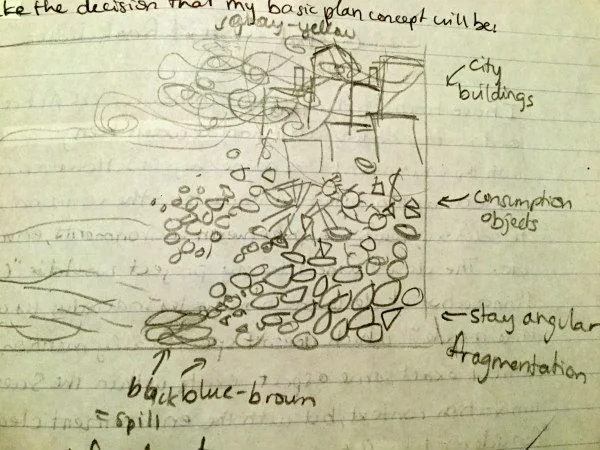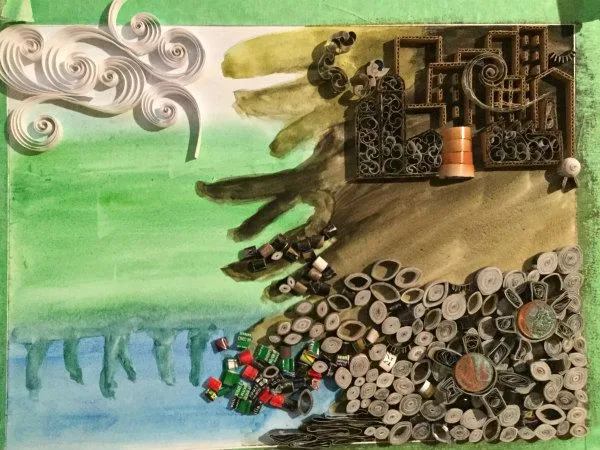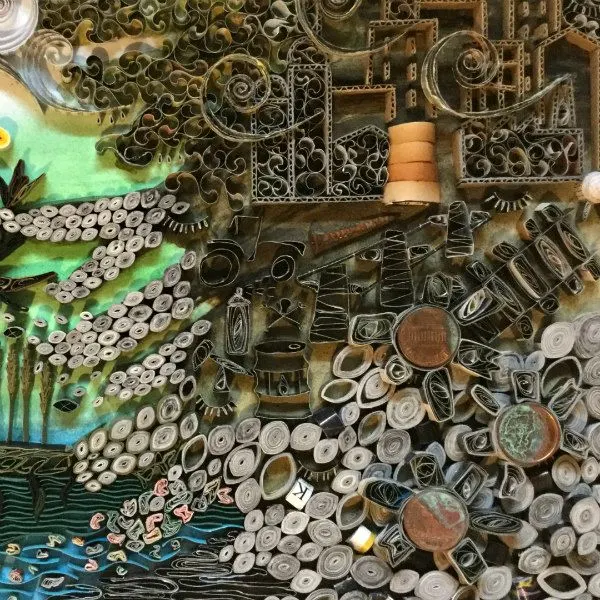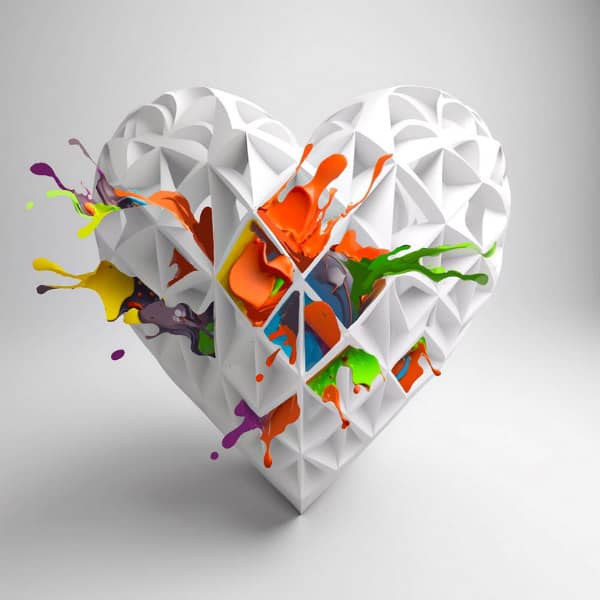Quilled Landscape Addresses Environmental Pollution
Here's an uplifting story that I think you'll enjoy whether or not you quill. (You may need to read to the end to see why I chose to use this descriptor in conjunction with such a serious topic.) Last May I was contacted by sixteen year old high school student, Sarah Nicole in Quebec, Canada, who was about to embark on a significant quilled piece that would be a year-long project as part of her IB course work.
I was impressed by the attention to detail with which Sarah explained the feedback she would need from me as a resource person in the coming months, and her reasons for choosing quilling in particular:
As I have been fascinated by quilling for a few years, I have decided to make a quilled piece about the environment in order to sensitize the students from my school to environmental issues, but also to the art of quilling, which is very unknown where I live.
Sarah mapped out a schedule and planned the design over the summer, and in early September sent both to me for approval, always polite and thoughtful as to her use of my time... no worries there, as I was happy to help and I'm sure the other worldwide quillers she was in touch with about the project were too. With a handful of us offering suggestions and answering questions, Sarah was kept busy just keeping track of our emails - quillers love to give advice! - but she was careful to respond to each suggestion after experimenting to see what worked and what didn't.
Sarah emailed sketches that showed she would create a densely quilled landscape.
My main idea right now is to represent nature through three areas (water, land, and sky) on the left side, which will be filled with different shapes with different movements, and to represent pollution through a dark wave of tight coils and geometric shapes coming from the right.
Sarah asked about background material and colors, framing, use of blank space, ways to create a sense of movement, and in what order I would recommend quilling the design. She planned to use 1/4 inch strips, cutting by hand the ones that would be made from discarded paper. By October she had purchased an 11 x 14" shadow box frame and was considering foam core board as the background. She asked about the type of paint to use, watercolor or acrylic, and whether I had experience with either reacting to the white craft glue she would be using. I suggested acrylic paint since I thought it would dry quickly on the board's surface, however, after experimenting Sarah found watercolor was satisfactory for her purposes.
Earlier this month she wrote to say the quilling was about halfway completed and she would be working on it during her school's spring break. We discussed which quilling techniques would be best used to convey opposing sides.
I'm trying to figure out what I'm going to do in the green part (natural part with plants and a tree). I want to make a tree in the center (kind of a tree of life) that will be attacked by tentacles of pollution (made of tiny oval tight coils) and turned partly black and leafless. It will have smaller plants growing under it and fireflies (circles of light) around it.
Two weeks later she sent over photos of the finished piece, Invasion. Can you pick out the objects she chose to represent pollution? It's a bit like a game of hidden pictures.
There is a pumpjack just above the lower closed eye, the outline of a tractor below the city/beside the screw, as well as electrical pylons and an oil barrel.
The coins on top of broken gears represent the way our linear economy (making, buying, throwing away) fuels pollution and is therefore broken because it is not sustainable. The three stacked coils on top of the city are the smoke emitted by industries that collects into a denser smog, and at the same time pushes the smog onto the nature side, becoming acid rain.
I asked Sarah if she plans to continue quilling:
Yes, mostly as a way to relax and take a break from schoolwork. I'd like to try other projects with recycled paper, maybe those abstract, stacked round tight coils with colored layers. I also like everything that has writing, flowers or plants involved. I'd also like to try improvising mindlessly, just to see where that would take me.
Why did I use the word uplifting to describe this post? Environmental pollution is far from a happy subject. However, the informed thought and fine work this realistic young person put into creating Invasion should give us hope for Earth's future, not to mention it's always fun to see someone take to a new hobby, especially the kind that can be picked up at any time throughout one's life.
I was impressed by the attention to detail with which Sarah explained the feedback she would need from me as a resource person in the coming months, and her reasons for choosing quilling in particular:
As I have been fascinated by quilling for a few years, I have decided to make a quilled piece about the environment in order to sensitize the students from my school to environmental issues, but also to the art of quilling, which is very unknown where I live.
Sarah mapped out a schedule and planned the design over the summer, and in early September sent both to me for approval, always polite and thoughtful as to her use of my time... no worries there, as I was happy to help and I'm sure the other worldwide quillers she was in touch with about the project were too. With a handful of us offering suggestions and answering questions, Sarah was kept busy just keeping track of our emails - quillers love to give advice! - but she was careful to respond to each suggestion after experimenting to see what worked and what didn't.
Sarah emailed sketches that showed she would create a densely quilled landscape.
My main idea right now is to represent nature through three areas (water, land, and sky) on the left side, which will be filled with different shapes with different movements, and to represent pollution through a dark wave of tight coils and geometric shapes coming from the right.
Sarah asked about background material and colors, framing, use of blank space, ways to create a sense of movement, and in what order I would recommend quilling the design. She planned to use 1/4 inch strips, cutting by hand the ones that would be made from discarded paper. By October she had purchased an 11 x 14" shadow box frame and was considering foam core board as the background. She asked about the type of paint to use, watercolor or acrylic, and whether I had experience with either reacting to the white craft glue she would be using. I suggested acrylic paint since I thought it would dry quickly on the board's surface, however, after experimenting Sarah found watercolor was satisfactory for her purposes.
Earlier this month she wrote to say the quilling was about halfway completed and she would be working on it during her school's spring break. We discussed which quilling techniques would be best used to convey opposing sides.
I'm trying to figure out what I'm going to do in the green part (natural part with plants and a tree). I want to make a tree in the center (kind of a tree of life) that will be attacked by tentacles of pollution (made of tiny oval tight coils) and turned partly black and leafless. It will have smaller plants growing under it and fireflies (circles of light) around it.
Two weeks later she sent over photos of the finished piece, Invasion. Can you pick out the objects she chose to represent pollution? It's a bit like a game of hidden pictures.
There is a pumpjack just above the lower closed eye, the outline of a tractor below the city/beside the screw, as well as electrical pylons and an oil barrel.
The coins on top of broken gears represent the way our linear economy (making, buying, throwing away) fuels pollution and is therefore broken because it is not sustainable. The three stacked coils on top of the city are the smoke emitted by industries that collects into a denser smog, and at the same time pushes the smog onto the nature side, becoming acid rain.
I asked Sarah if she plans to continue quilling:
Yes, mostly as a way to relax and take a break from schoolwork. I'd like to try other projects with recycled paper, maybe those abstract, stacked round tight coils with colored layers. I also like everything that has writing, flowers or plants involved. I'd also like to try improvising mindlessly, just to see where that would take me.
Why did I use the word uplifting to describe this post? Environmental pollution is far from a happy subject. However, the informed thought and fine work this realistic young person put into creating Invasion should give us hope for Earth's future, not to mention it's always fun to see someone take to a new hobby, especially the kind that can be picked up at any time throughout one's life.








